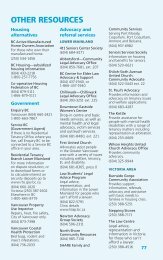Young v. Saanich Police Department, 2003 BCSC 926 (CanLII).
Young v. Saanich Police Department, 2003 BCSC 926 (CanLII).
Young v. Saanich Police Department, 2003 BCSC 926 (CanLII).
You also want an ePaper? Increase the reach of your titles
YUMPU automatically turns print PDFs into web optimized ePapers that Google loves.
<strong>Young</strong> v. <strong>Saanich</strong> <strong>Police</strong> <strong>Department</strong>, et al Page 65<br />
considering relevant matters, making serious procedural errors<br />
or, in some circumstances, making an error of law. A<br />
discussion of most of these general principles may be found in<br />
Mikami v. Ambrozewicz, 2000 <strong>BCSC</strong> 1116.<br />
[137] Smith J. discussed the standard of review to be<br />
applied to arbitrators appointed under the RTA in Fulber v.<br />
Doll, 2001 <strong>BCSC</strong> 891. I adopt what she said, at paras. 55 and<br />
<strong>2003</strong> <strong>BCSC</strong> <strong>926</strong> (<strong>CanLII</strong>)<br />
63, and apply it to my review of Arbitrator Gilbert's factual<br />
conclusion that the presence of marihuana smoke unreasonably<br />
interfered with the enjoyment of other tenants:<br />
55 In determining the standard of review on<br />
substantive issues, the Supreme Court of Canada<br />
requires courts to take a "pragmatic and functional<br />
approach": (Citations omitted.) Standards of review<br />
appear on a spectrum ranging from least deferential<br />
(correctness) to more deferential (reasonableness<br />
simpliciter, which I will call "simple<br />
reasonableness") to most deferential (patent<br />
unreasonableness). To determine the appropriate<br />
standard of review, the court is to take into<br />
account a number of factors: (1) the existence of a<br />
privative clause or statutory right of appeal; (2)<br />
the expertise of the tribunal, in particular in<br />
relation to the expertise of the court; (3) the<br />
purpose of the statute and of the particular<br />
provision; and (4) the nature of the problem, be it<br />
a question of law, fact, or mixed law and fact:<br />
(Citations omitted.) ...<br />
63 Applying the four factors the Supreme Court has<br />
identified in Baker and Pushpanathan, I note the<br />
following. First, there is a "finality" clause,<br />
though not a "full" privative clause. Section 57(3)<br />
of the Act states that "Except as otherwise provided<br />
in this Act, a decision or order of an arbitrator is<br />
final and binding on the parties". Second, given











